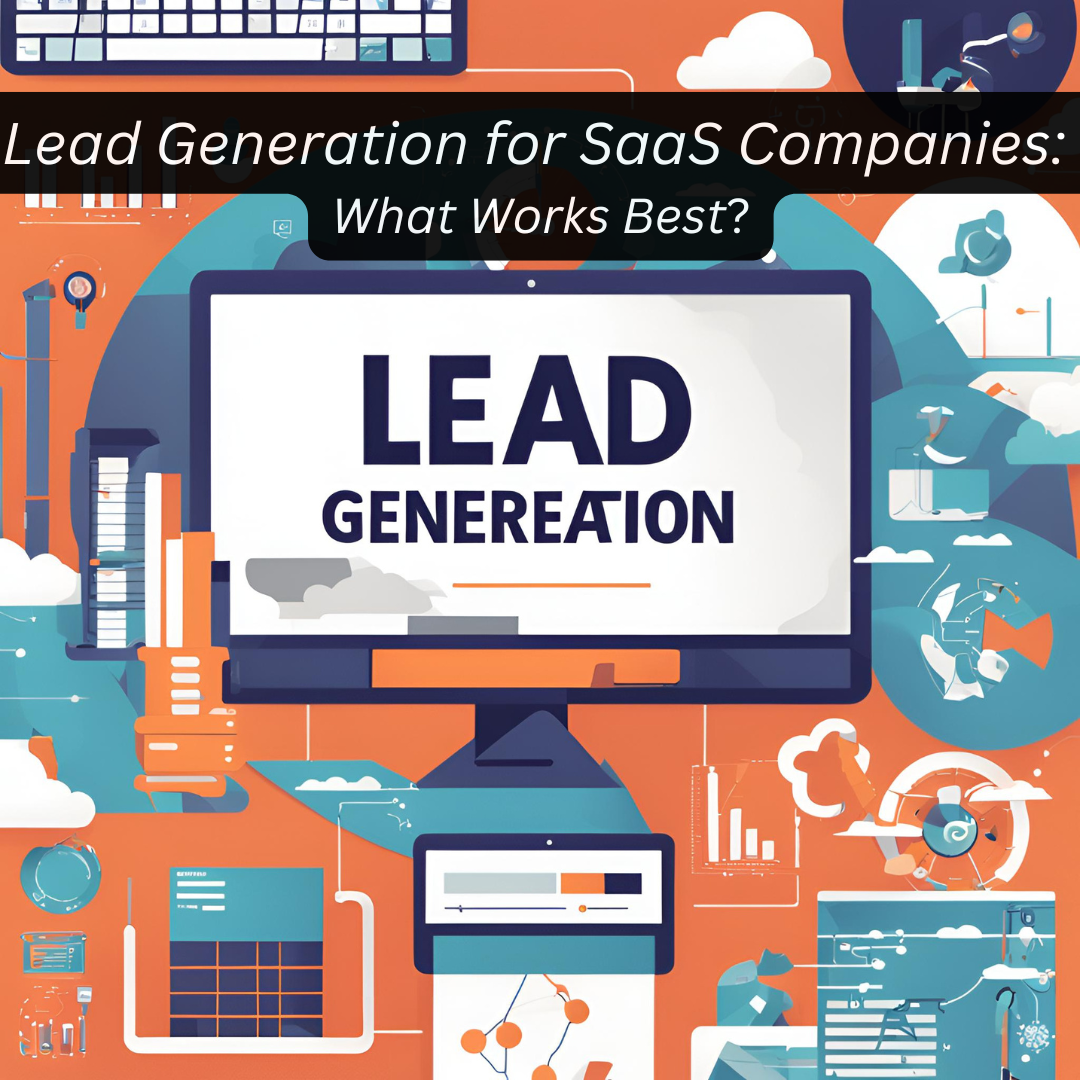Lead generation in the extremely competitive SaaS industry should not just relate to gathering a list of potential customers but also getting the quality lead who wants or requires a solution. Taking into account the subscription-based model and wide needs amongst potential users, SaaS companies require strategic attracting, nurturing, and converting leads into paying customers.
In this blog, we discuss a structured framework with leading and innovative strategies toward generating leads in the traditional way as well as the more effective ways designed for building relationships, showing value, and finally converting leads in the SaaS market. Content marketing and free trials, targeted advertising, and data analytics could create a healthy lead stream capable of causing excellent growth and retention for SaaS companies.
1. Identify and Define the Ideal Customer Profile (ICP)
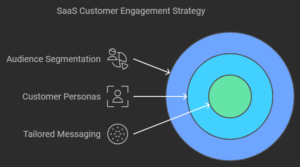
For SaaS companies, the identification of an ICP needs to be clear to target the audience. Audience segmentation will form the starting point as it can be used to group prospects initially by industry, company size, specific needs, and pain points. This then allows proper messaging and solution tailoring in order to resonate with each challenge brought about in that segment.
Create Customer Persona-developed, full-depth profiles that include demographic/age, role/company size data, behavioral/usage patterns and purchasing behaviors, and psychographic/values, challenges, and goals. Information drawn from personas speaks to what motivates each type of customer and how to position the product and engage with this customer group.
Finally, knowledge of the Buyer’s Journey will likely shape content for each step. During the awareness stage, you want to focus on learning content that will answer the pain points; in the consideration stage, you will want to offer comparisons and solutions; finally, in the decision stage, you will want to show case studies and the benefits of the product. Mapped journeys ensure that every piece of content moves prospects through the eventual conversion phase.
2. Build a High-Converting SaaS Website
A SaaS website that converts high will turn visitors into leads. Start with Optimized Landing Pages by focusing on a feature, benefit, or target user segment for each one. Each landing page should focus on a unique aspect of the product: information relevant to each visitor’s specific needs or pain points. This focused approach increases engagement potential, as it delivers content and relevance with each visitor type.

Then craft a Clear Value Proposition – a statement that is immediately apparent that, in a few words, clearly articulates what sets your SaaS product apart. Explain how the product solves particular problems and what values it provides to the customers actual dollar saving to increased productivity, etc. A clear value proposition can enable the visitors to grasp how it addresses specific challenges quickly.
Finally, use effective Call-to-Action (CTA) buttons. This is where CTAs need to be action-oriented and should be tempting enough to make users click on them, such as “Start Your Free Trial” or “Get a Demo.” Compelling CTAs motivate users to take the next step toward converting.
3. Content Marketing Strategy for Organic Reach
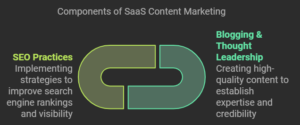
Content marketing is essential to organic lead generation for most SaaS companies. This usually begins as a construction of Blogging & Thought Leadership- high-quality blogs, whitepapers, and guides on topics of relevance because they speak to areas of expertise that your audience cares about. This continues to establish credibility for your brand and position the brand as a trusted resource, which will bring in potential leads.
Another very important component of the strategy is effective SEO for SaaS. Practices include targeted words specific to SaaS that the prospects are actually searching for, optimized meta descriptions for improved click-through rates, and schema markup for better search result visibility, which improves search engine rankings and drives qualified organic traffic.
Use Guest Posts & Backlinks for extension. Guest posts published in good SaaS or tech sites allow leveraging a wider audience and earning backlinks to also boost SEO, and it enhances authority, attracting leads who are already interested in SaaS solutions.
4. Leverage Free Trials and Demos
Free trials and demos can be major SaaS lead generation for prospects to enjoy a firsthand feel of the product. Start with freemium models, whereby you offer limited functionality or usage at no cost. The potential users get a taste of the product, and they are motivated to deepen the benefits, not committing themselves. Freemium models are very effective in building trust and showing immediate value.
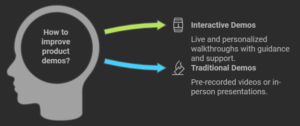
Interactive Demos are yet another interactive option. Here, you have live and personalized walkthroughs. It can allow the demoing of your product with guidance and support to help prospects address their pain points or see specific features they’re concerned about. Personalized demos increase the connection the prospect makes with the product and shorten the decision-making process.
Trial Optimization Optimize for engagement: Simplify the sign-up process and then support the users with tutorials, onboarding emails, or support b. This smoothly guides the user through the product, enhancing the user experience, and thus having a high potential for conversion.
5. Implement Targeted Email Marketing Campaigns
For a SaaS business, targeted email marketing would be necessary for nurturing leads and moving them along the customer journey. Start with a Lead Nurturing Series, by creating automated email sequences tailored to these different stages—the awareness, trial, and post-trial. Awareness-stage emails might have such as product information, trial-stage emails can show tips on best practices for using the product to optimize usage, while post-trial emails provide conversion incentives.

There are various campaigns- Personalization and segmentation-enhancing these by delivering content based on the behavior and preferences of the users. Dynamic emails make relevant experiences that resonate with each recipient, which helps create engagement and loyalty.
Last but not least, Re-engagement Campaigns work on leads who expressed interest but did not convert. It is timely to offer a lead something, like a discount or a story of success that outlines their pain points. Customer testimonials or use cases are what revive interest in re-engagement campaigns.
6. Paid Advertising for SaaS Lead Generation
Paid advertising drives high-intent leads into SaaS companies because you are serving ads to users who actively are in search of a solution. Start with Google Ads for Intent-Driven Leads: capturing demand by bidding on keywords related to your SaaS product, for example, “best project management software.” The conversion is more likely with the right keyword selection just shows the ads where prospects are looking for a solution.
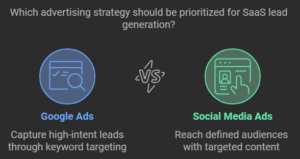
Social Media Ads on platforms like LinkedIn, Facebook, or Twitter can also reach defined audiences. For example, LinkedIn allows targeting by job title, industry, and company size, which makes it ideal for B2B SaaS products. In this case, Facebook and Twitter ads can also build awareness and drive interest when properly created, engaging visuals or video content are used.
Finally, Retargeting Ads are important to re-engage visitors who have shown interest but abandoned at a non-converting stage. These remind users about your product and act as an encouragement for them to come back and often drive them along the conversion funnel.
7. Leverage Social Proof and Testimonials
Social proof in SaaS marketing is important because it increases credibility and makes prospects believe that a similar set of users are having the desired outcomes with your product. Begin with Case Studies & Success Stories that indicate concrete results achieved through your product, with metrics about time saved or revenue growth. The prospects will be able to imagine the outcome of your product and associate it with the issues they may have had.
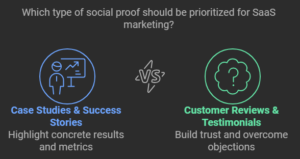
Customer Reviews and Testimonials are equal as well to build trust. Bring out truthful reviews on any website, landing page, or even on the product page. Testimonials can help overcome potential objections and give a sense of utility based on user experiences while making the product even more appealing by letting the customers speak for it.
Engage to get people to give their feedback on Third-Party Review Sites like G2, Capterra, and Trustpilot. Positive reviews on these channels improve your brand reputation and make prospects more likely to be looking into alternative options and choose your solution. Such public validation is a good trigger for producing newer leads and increasing conversion.
8. Use Data Analytics to Optimize Campaigns
It helps SaaS companies fine-tune lead generation and maximize return on investment. Start tracking some key metrics: CAC, LTV, conversion rates, and churn rates. They’re benchmarking the cost-effectiveness and profitability of campaigns, guiding where to spend resources and which strategies to refine.
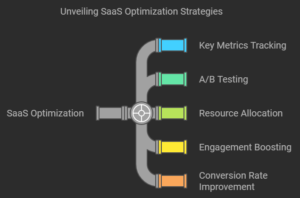
It achieves continuous optimization through A/B testing. It tests everything the placement of CTA, email subject lines, and ad creative learn what works best for your audience. A/B testing provides actionable insights toward boosting engagement and conversion rates over time.
Finally, use CRM and lead scoring to make the lead management process easier. Implement lead scoring so prospects are ranked based on engagement, demographics, and other behaviors. In this way, a good sales team can prioritize top-quality leads, making their follow-up efforts more efficient and upping conversion rates in general.
Conclusion
Quality lead generation for SaaS companies demands more than creativity and data-driven inputs, but rather a user-centric approach. A well-thought-out strategy that fits in with the customer journey will attract only the right kind of high-quality leads for SaaS companies that will convert through positive interactions and remain through good experiences. Ultimately, this makes it easier to transition from awareness to acquisition.
In the SaaS landscape, therefore, only those who maintain their adaptability and take time to think about the real needs of their audience will stand out-gain more conversions and build long-lasting customer relationships.
